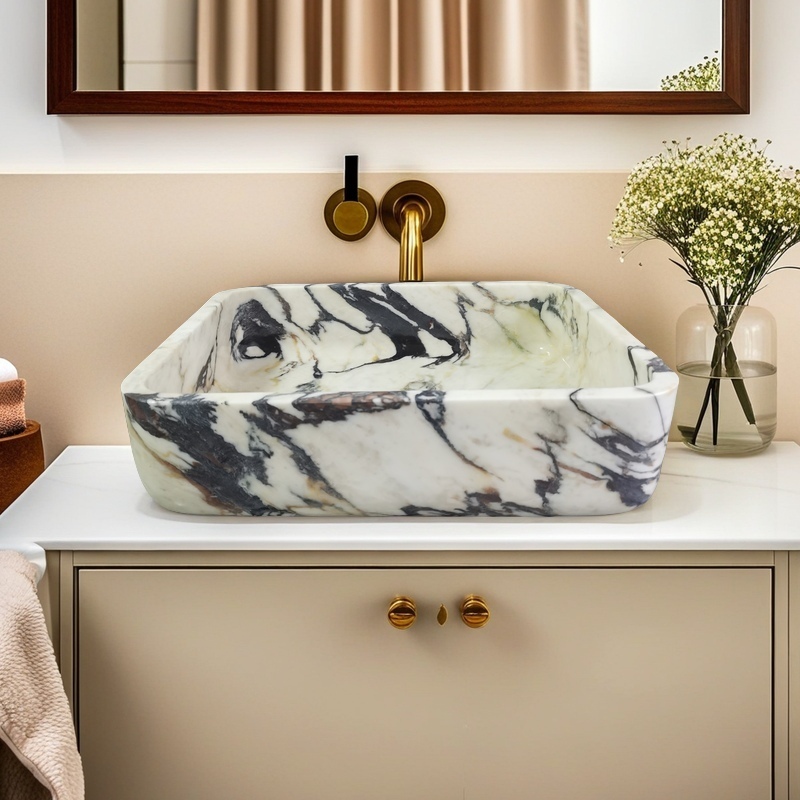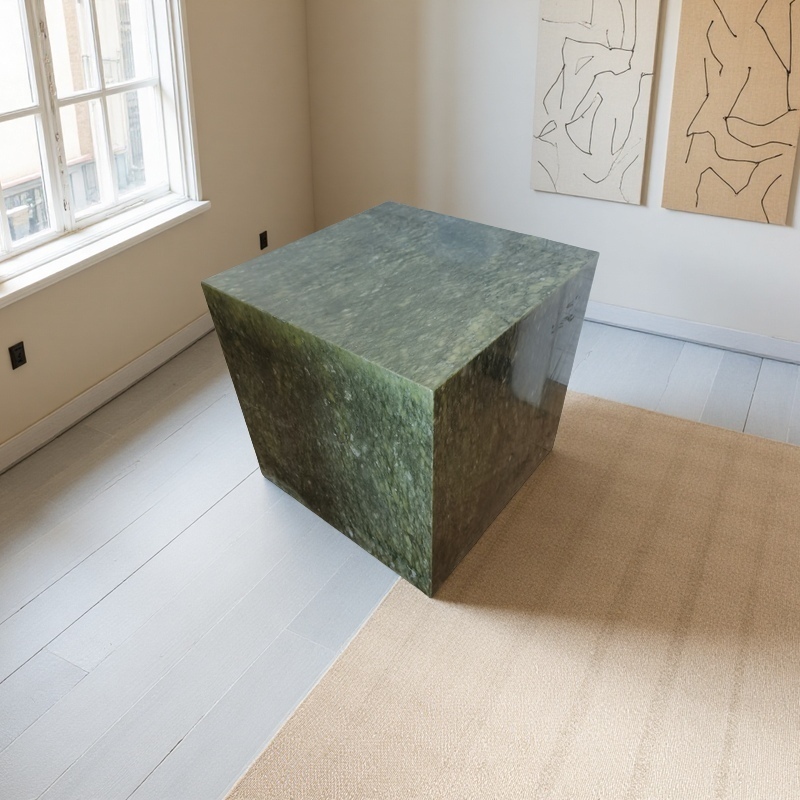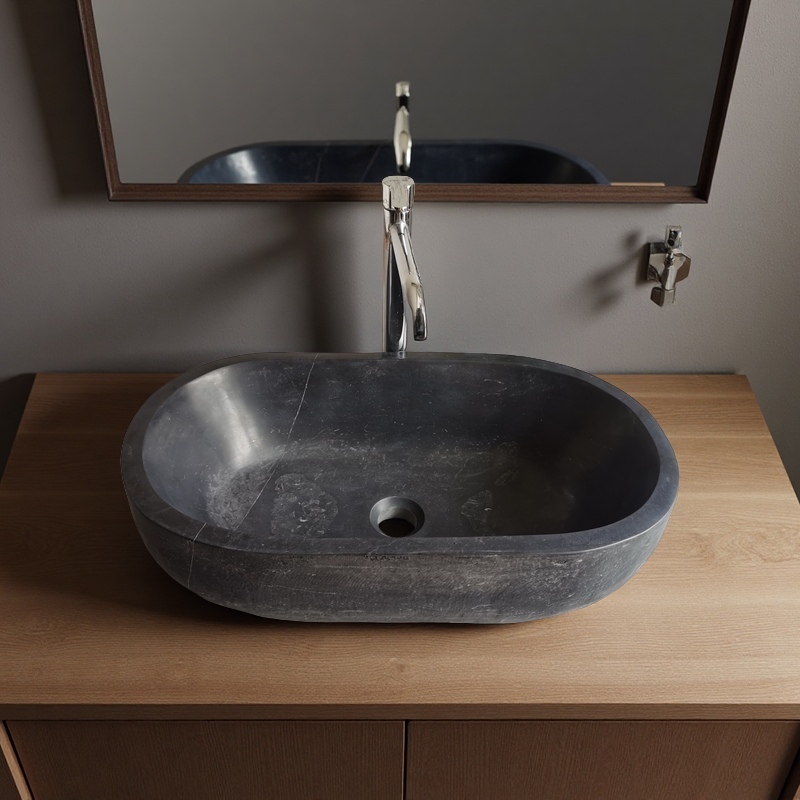How to Choose Natural Stone Bathroom Fixtures?
In recent years, natural stone bathroom fixtures have become a popular choice for homeowners pursuing high-end and natural home aesthetics. However, with a variety of natural stone materials available, such as granite, marble, and sandstone, many people feel confused when making a purchase. The key to solving this confusion lies in understanding the natural stone bathroom material differences and mastering the stone sink buying guide. This blog will help you quickly grasp the characteristics of different natural stones, learn practical identification methods, and know how to maintain them, so that you can make a wise choice in just 3 minutes.

1. Material Comparison: Granite, Marble, Sandstone - Which One Is Right for Your Bathroom?
To clearly understand the differences between various natural stone materials, we have summarized their advantages, disadvantages, and applicable scenarios in the form of a table. This will help you directly compare and find the most suitable material for your bathroom needs.
Material | Advantages | Disadvantages | Applicable Scenarios |
Granite | 1. High hardness (Mohs hardness 6-7), wear-resistant and scratch-resistant, not easy to be damaged by daily use.2. Low water absorption rate (usually less than 0.4%), good water resistance, and not easy to seep water and breed bacteria.3. Strong durability, can maintain good condition for a long time with proper maintenance. | 1. The color and texture options are relatively limited compared to marble, mostly dark colors such as gray and black.2. The processing difficulty is relatively high, and the cost of custom-shaped products may be higher. | It is very suitable for bathroom sinks, especially the main sink that is used frequently. Because the sink needs to withstand frequent water flow, cleaning, and even occasional collisions, the high hardness and low water absorption of granite can well meet these needs. |
Marble | 1. High appearance value, with unique and beautiful natural textures, such as veined patterns, which can add a sense of luxury and elegance to the bathroom.2. Rich color options, including white, beige, gray, and even colorful varieties, which can match different bathroom decoration styles.3. The surface is smooth and delicate, giving a comfortable touch. | 1. Low hardness (Mohs hardness 3-4), easy to be scratched and worn, and not suitable for areas with high friction. 2. High water absorption rate (usually 0.5%-1.5%), easy to seep water and absorb stains, requiring frequent maintenance. | It is ideal for bathroom vanities and hand wash basins. The beautiful appearance of marble can make the hand wash area the visual focus of the bathroom, and as long as it is not subject to strong impact and frequent friction, it can show its advantages well. |
Sandstone | 1. Unique texture, with natural granular sense and rough surface, which can create a natural, primitive, or industrial-style bathroom atmosphere, suitable for niche design needs.2. Good thermal insulation performance, not easy to feel cold when touched in winter. | 1. High water absorption rate (some varieties can reach more than 2%), poor water resistance, easy to seep water and get moldy if not maintained properly.2. Low strength and poor impact resistance, easy to crack or break when subjected to external force. | It is suitable for niche-designed bathrooms, such as rural-style or industrial-style bathrooms. It can be used as decorative panels around the hand wash basin or as a small-sized auxiliary hand wash basin, but it is not recommended to be used as the main sink that is used frequently. |
2. Identification Method: 3 Steps to Judge the Authenticity of Natural Stone Bathroom Fixtures
When purchasing natural stone bathroom fixtures, it is crucial to distinguish between genuine natural stone and fake or artificial stone. The following 3 simple steps can help you easily judge the authenticity, which is an important part of the stone sink buying guide.

Step 1: Observe the Natural Degree of Texture
Genuine natural stone has unique and irregular textures. Each piece of natural stone has a different texture, and there will be no completely repeated patterns. For example, the veining of marble is natural and random, sometimes thick and sometimes thin, and there will be slight color differences in different parts. On the contrary, artificial stone or fake natural stone usually has regular textures, and the patterns are often repeated in a certain cycle. You can observe the entire surface of the fixture carefully. If you find that the textures are highly similar or even identical in multiple positions, it is likely to be a fake product.
In addition, you can also look at the edge of the stone. The edge of genuine natural stone is usually more natural, and there may be slight unevenness due to the natural formation process. While the edge of artificial stone is often very smooth and neat, and there is no natural texture transition.
Step 2: Test the Water Absorption Rate
The water absorption rate is an important indicator to distinguish natural stone from artificial stone, and it is also closely related to the later use and maintenance of the fixture. The water absorption rate of genuine natural stone is relatively stable (as shown in the material comparison table), while the water absorption rate of artificial stone is often either too high (due to poor material quality) or too low (due to excessive addition of waterproof agents).
The specific test method is: take a clean cloth and wipe the surface of the stone to ensure it is dry. Then drop a few drops of clean water on the surface of the stone (it is best to choose an inconspicuous position, such as the bottom of the sink). Observe the diffusion and absorption of the water droplets. If the water droplets remain on the surface for a long time (more than 5 minutes) without being absorbed, and there is no obvious diffusion, it may be a natural stone with low water absorption rate, such as granite. If the water droplets are slowly absorbed (within 1-3 minutes) and leave a slight water mark, it may be marble or sandstone. However, if the water droplets are quickly absorbed (within 30 seconds) and the water mark is very obvious, or the water droplets do not spread at all and slide off like on a plastic surface, it is likely to be artificial stone or fake natural stone.
It should be noted that this test method is a preliminary judgment. For more accurate results, you can also ask the merchant for the official water absorption rate test report of the product.

Step 3: Check the Test Report
Formal natural stone bathroom fixture merchants will provide customers with relevant test reports, which are the most authoritative basis for judging the authenticity and quality of the product. When checking the test report, you should focus on the following two aspects:
First, check the "radioactive level test result". According to the national standard, natural stone is divided into three categories: Class A, Class B, and Class C. Among them, only Class A natural stone can be used in indoor environments (including bathrooms) because its radioactive level meets the indoor safety standards and will not cause harm to human health. If the test report shows that the stone is Class B or Class C, or there is no radioactive level test result at all, it is not recommended to purchase it for bathroom use.
Second, check the "density and water absorption rate test results". The density and water absorption rate of genuine natural stone are within a certain range. For example, the density of granite is usually 2.6-2.7g/cm³, and the water absorption rate is less than 0.4%; the density of marble is 2.5-2.6g/cm³, and the water absorption rate is 0.5%-1.5%. If the data in the test report is far from these ranges, it may be a fake product.
In addition, you should also check whether the test report is issued by a formal testing institution (with the official seal of the testing institution) and whether the test date is within the valid period. If the merchant refuses to provide the test report or the test report is incomplete, you should be cautious when purchasing.
3. Maintenance Points: Make Your Natural Stone Bathroom Fixtures Last Longer
After purchasing genuine natural stone bathroom fixtures, proper maintenance is essential to maintain their appearance and extend their service life. Here are some key maintenance points:
1. Forbid the Use of Acidic Cleaners
Natural stone (especially marble) is sensitive to acidic substances. Acidic cleaners such as vinegar, lemon juice, toilet cleaners containing hydrochloric acid, and tile cleaners will corrode the surface of the stone, causing the surface to lose luster, appear small pits, or even change color. Therefore, when cleaning natural stone bathroom fixtures, you must use neutral cleaners. For example, you can use a special natural stone cleaner (with a pH value of 7-8) or a mild soapy water. When using a new cleaner, it is recommended to test it on an inconspicuous part of the stone first to ensure that it will not cause damage to the stone.

2. Recommend the Use of Special Stone Maintenance Fluids
To enhance the water resistance and stain resistance of natural stone bathroom fixtures and prevent the stone from being damaged by daily use, it is recommended to use special stone maintenance fluids regularly. We have cooperated with several well-known stone maintenance brands to provide you with reliable product recommendations (the following are cooperative brands, and you can purchase them through official channels):
• Brand 1: StoneGuard Pro
◦ Product Features: This maintenance fluid is suitable for various natural stones, including granite, marble, and sandstone. It can form a transparent protective film on the surface of the stone, which has strong water resistance and stain resistance, and can effectively prevent water seepage and stain adsorption. At the same time, it can also enhance the luster of the stone and make the texture of the stone more prominent.
◦ Usage Method: First, clean the surface of the stone and dry it. Then spray the maintenance fluid evenly on the surface of the stone (the amount should be moderate, not too much). Wait for 5-10 minutes to let the maintenance fluid be fully absorbed by the stone. Finally, wipe the surface with a clean dry cloth to remove the excess maintenance fluid. It is recommended to use it once every 3 months.
• Brand 2: MarbleLife Elite
◦ Product Features: This maintenance fluid is specially designed for marble. It has a mild formula and will not corrode the surface of marble. It can effectively repair the small scratches on the surface of marble, fill the tiny pores of the stone, and improve the water resistance and stain resistance of marble. After use, the surface of marble will become more smooth and bright.
◦ Usage Method: Clean the marble surface and dry it. Apply a small amount of maintenance fluid to the surface with a clean sponge, and wipe it evenly in a circular motion. Wait for 15-20 minutes, then polish the surface with a soft dry cloth until the surface is bright. It is recommended to use it once every 2 months for frequently used marble hand wash basins.
• Brand 3: GraniteShield Ultra
◦ Product Features: This maintenance fluid is mainly used for granite. It has high hardness and can form a wear-resistant protective layer on the surface of granite, which can effectively resist scratches and wear caused by daily use. It also has good water resistance, which can prevent water from seeping into the interior of the granite and causing mold.
◦ Usage Method: Clean the granite surface and dry it. Pour an appropriate amount of maintenance fluid into a container, dip a clean cloth into the maintenance fluid, and wipe the granite surface evenly. Wait for 10-15 minutes, then wipe the surface with a dry cloth to make the surface smooth. It is recommended to use it once every 6 months.

3. Daily Maintenance Tips
In addition to using the correct cleaners and maintenance fluids, there are some daily maintenance tips that can help you better protect your natural stone bathroom fixtures:
• After using the sink or hand wash basin, wipe the surface with a clean dry cloth in time to remove water stains and prevent water spots from forming on the surface.
• Avoid placing heavy objects (such as large flower pots, heavy toiletries) on the edge of the stone fixture, so as not to cause the stone to crack due to excessive pressure.
• If there are stains (such as toothpaste stains, soap stains) on the surface of the stone, clean them in time. Do not let the stains stay on the surface for a long time, otherwise, they may penetrate into the interior of the stone and be difficult to clean.
• For sandstone fixtures with high water absorption rate, it is necessary to increase the frequency of maintenance (such as using maintenance fluid once every 1-2 months) to ensure that the stone is in a good water-resistant state.
Conclusion
Choosing natural stone bathroom fixtures is not a complicated thing. As long as you understand the natural stone bathroom material differences, master the 3-step identification method in the stone sink buying guide, and do a good job in daily maintenance, you can easily select high-quality and suitable natural stone bathroom fixtures. Whether you choose granite for its durability, marble for its beauty, or sandstone for its unique style, as long as you use and maintain it correctly, it will bring a natural and high-end atmosphere to your bathroom and accompany you for a long time.
If you have any other questions about natural stone bathroom fixtures, such as how to match with the bathroom decoration style or how to solve common problems in use, you can leave a message in the comment area below. We will reply to you as soon as possible and provide you with more professional advice!
